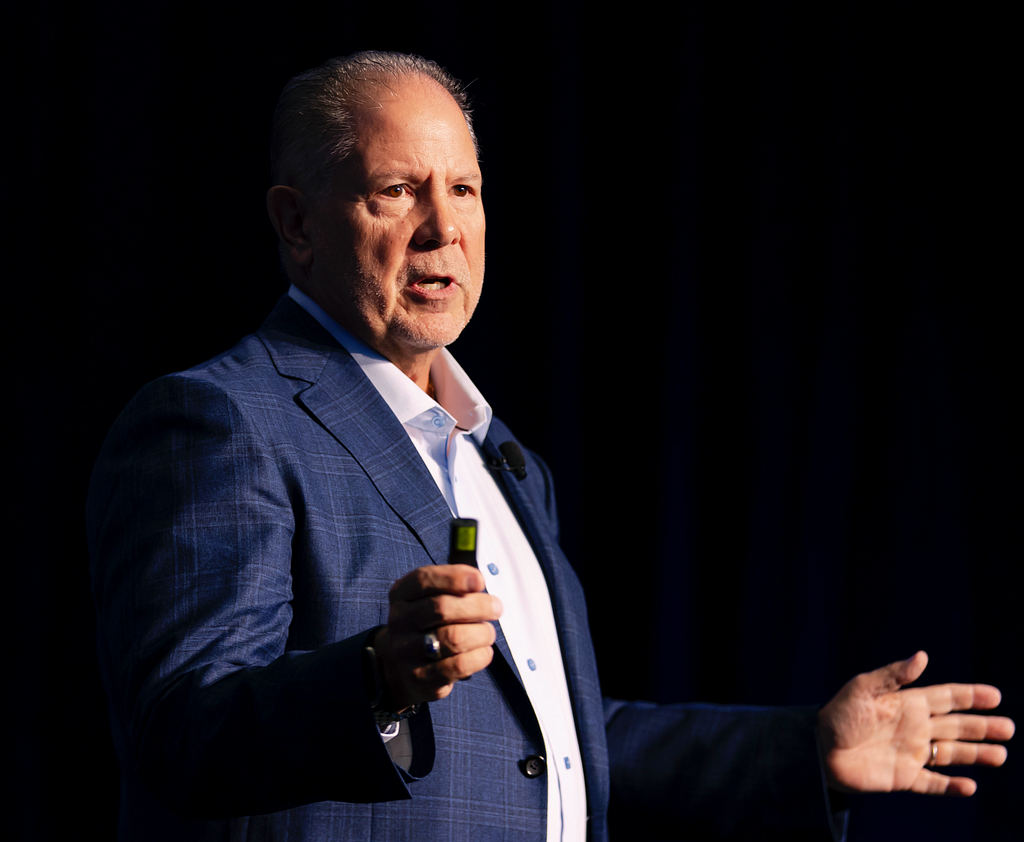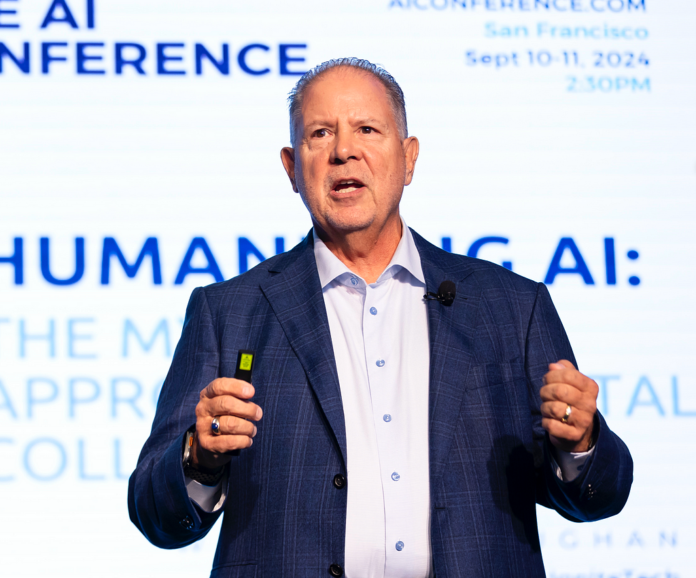C-Suite Perspectives On AI: Eric Vaughan of IgniteTech On Where to Use AI and Where to Rely Only on Humans
An Interview With Kieran Powell
Continuous learning: Prioritize ongoing improvement for both AI systems and human employees. This ensures that both continue to evolve and complement each other effectively.
As artificial intelligence (AI) continues to advance and integrate into various aspects of business, decision-makers at the highest levels face the complex task of determining where AI can be most effectively utilized and where the human touch remains irreplaceable. This series seeks to explore the nuanced decisions made by C-Suite executives regarding the implementation of AI in their operations. As part of this series, we had the pleasure of interviewing Eric Vaughan.
Eric Vaughan is the Chief Executive Officer of IgniteTech, a leading enterprise technology company at the forefront of the AI revolution and of GFI Software, an IT solutions marketplace for small and medium businesses deploying network management and performance, security and collaboration offerings. Eric is responsible for setting and executing the company’s strategic vision and leading the global IgniteTech team as they leverage transformative AI technologies to drive continued business success and deliver exceptional customer value.
With over 20 years of experience as a technology and M&A executive, Eric is widely recognized as an innovative force in the enterprise software space. As CEO, he spearheads IgniteTech’s transformation into an AI-first organization, having built a talented, future-ready team skilled in cutting-edge AI development. Under Eric’s vision, IgniteTech is positioned as a leader in helping customers seamlessly transition into the AI era, equipping them with the tools and expertise to thrive in this transformative landscape.
Thank you so much for your time! I know that you are a very busy person. Our readers would love to “get to know you” a bit better. Can you tell us your ‘backstory’ and how you got started?
My 30-year tech journey began as a software developer, driven by a fascination with interfaces and democratizing technology. Bucking the trend of entering employment first, I bought my first small software company. This hands-on experience shaped my leadership approach at IgniteTech and GFI Software, where we focus on making powerful, user-friendly enterprise software and IT solutions accessible to businesses of all sizes.
I’ve been committed to bridging the gap between complex technology and everyday users throughout my career. This vision has been the cornerstone of our success in developing solutions that are not only powerful but also intuitive and accessible.
Can you share a story about your funniest mistake when first starting? What lesson did you learn from that?
Early in my career, we spent months developing an incredibly powerful feature set, only to realize during a client demo that our interface was so complex that even our team struggled to navigate it smoothly. Watching the client’s eyes glaze over as we fumbled through the presentation was both embarrassing and enlightening.
This experience taught me a crucial lesson: no matter how impressive the technology, it’s worthless if people can’t easily use it. It forever changed my approach to product development. Now, we always keep the end-user front and center, ensuring that our powerful solutions are also intuitive and accessible. This user-centric approach has become our product philosophy’s cornerstone and a key market differentiator.
Are you working on any exciting new projects now? How do you think that will help people?
We’re developing a groundbreaking project called MyPersonas, which will revolutionize how businesses interact with AI. MyPersonas is an AI-powered system that creates virtual clones of subject matter experts within organizations.
Imagine consulting your company’s top legal expert, HR manager, or technical specialist anytime, without scheduling conflicts or time zone issues. These AI clones, available 24/7, can answer questions, provide guidance, and assist with tasks, improving efficiency and ensuring consistent information across the organization.
What sets MyPersonas apart is its ability to integrate with existing systems and data sources, ensuring the AI clones are always up-to-date. It’s not just about answering pre-programmed questions; these AI personas can engage in nuanced, context-aware conversations.
MyPersonas represents our vision of AI as a tool to augment and amplify human capabilities, not replace them. It’s about creating a symbiosis between human expertise and AI efficiency, and we’re incredibly excited about its potential to transform how businesses operate, especially in areas like knowledge sharing, customer support, and employee onboarding.
What have been the most challenging aspects of integrating AI into your business operations?
Our biggest challenge was initiating a cultural shift to become an AI-first organization. We implemented several initiatives to drive this transformation:
- A company-wide AI education program, providing resources and bringing in industry experts like Ethan Mollick for workshops.
- An engagement scoring system to measure employee participation in AI learning and projects.
- “AI Mondays” — dedicating every Monday solely to AI-related activities, essentially investing 20% of our payroll in AI advancement.
- Incentives and recognition for exceptional AI-related ideas and projects.
- Leadership by example, with me personally driving these initiatives.
Despite these efforts, we faced a harsh reality: not everyone could make this transition. Over five quarters, we replaced about 80% of our workforce to align with our AI-first vision. We hired new talent specifically for their AI aptitude and enthusiasm.
Notably, I personally interview every candidate for AI positions, regardless of department or role. It’s unusual for a CEO to be this involved in hiring, but it’s crucial we get this right. This hands-on approach ensures that every new team member is aligned with our vision and possesses the necessary skills and mindset for our AI-driven future.
This transformation was challenging and, at times, painful. However, it was necessary for our survival and growth in an AI-driven future. We’re now essentially an AI startup within a 30-year-old enterprise software company, poised to lead in the new AI landscape.
How do you navigate the ethical implications of implementing AI in your company?
We approach AI implementation not as job displacement but as an evolution of skillsets. It’s about AI-proficient humans replacing those who refuse to adapt, similar to past technological shifts like the introduction of automobiles or computers.
Our approach includes:
- Transparency and education about AI’s impact on roles and responsibilities.
- Emphasizing human-AI collaboration rather than replacement.
- Staying ahead of global AI innovations and ethical guidelines to inform our practices and advise customers.
- Supporting employees in the transition and ensuring that embracing AI skills is non-negotiable.
- Responsible innovation, designing AI tools like MyPersonas to augment human capabilities, not replace human judgment.
We believe that by embracing AI and staying informed about global ethical standards, we’re securing our company’s future and equipping our employees with invaluable skills for the evolving job market. Our goal is to create an environment where AI enhances human potential rather than diminishes it.

Based on your experience, what are the “5 Things To Keep in Mind When Deciding Where to Use AI and Where to Rely Only on Humans, and Why?”
- Task complexity: Use AI for repetitive, data-heavy tasks, and humans for complex, nuanced decision-making. This optimization allows humans to focus on high-value activities.
- Emotional intelligence: Prioritize human involvement where empathy and emotional intelligence are crucial. AI can provide information, but humans excel at understanding and responding to emotional nuances.
- Stakes of the decision: Ensure human oversight for high-stakes decisions with significant consequences. While AI can provide valuable insights, human judgment is essential for critical choices.
- Augmentation opportunities: Look for ways AI can enhance human capabilities rather than replace them. The most effective solutions often come from human-AI collaboration.
- Continuous learning: Prioritize ongoing improvement for both AI systems and human employees. This ensures that both continue to evolve and complement each other effectively.
These principles have guided our AI integration strategy, ensuring we leverage technology while valuing and enhancing our human talent. They’ve helped us navigate the complexities of AI implementation, resulting in improved efficiency, innovation, and employee satisfaction.
If you could start a movement that would bring the most good to the most people, what would that be?
I’d initiate an “AI Literacy for All” movement. Understanding AI — its capabilities, limitations, and implications — is becoming as crucial as basic literacy today. This movement would aim to educate people from all walks of life about AI, demystifying the technology, reducing fears, and empowering individuals to harness its potential responsibly.
We’d work to integrate AI education into school curricula, offer free online courses for adults, and partner with businesses to provide AI training for employees. The goal would be to ensure that as AI advances, it lifts all boats, not just a select few.
By fostering widespread AI literacy, we can create a future where AI enhances human potential rather than replacing it, and where the benefits of AI are distributed equitably across society. It’s an ambitious goal, but one that I believe is essential for navigating the rapidly evolving landscape of the 21st century.
This was very inspiring. Thank you so much for joining us!
About The Interviewer: Kieran Powell is the EVP of Channel V Media a New York City Public Relations agency with a global network of agency partners in over 30 countries. Kieran has advised more than 150 companies in the Technology, B2B, Retail and Financial sectors. Prior to taking over business operations at Channel V Media, Kieran held roles at Merrill Lynch, PwC and Ernst & Young. Get in touch with Kieran to discuss how marketing and public relations can be leveraged to achieve concrete business goals.
C-Suite Perspectives On AI: Eric Vaughan of IgniteTech On Where to Use AI and Where to Rely Only on… was originally published in Authority Magazine on Medium, where people are continuing the conversation by highlighting and responding to this story.


